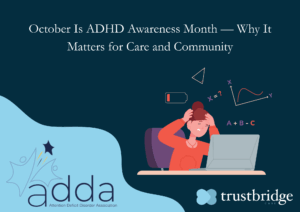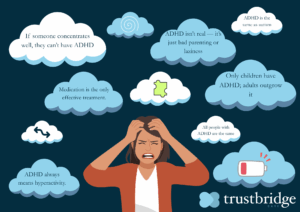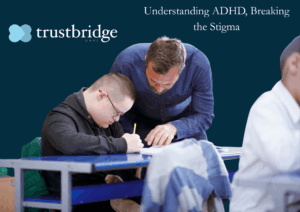
What Is ADHD?
- ADHD stands for Attention-Deficit/Hyperactivity Disorder. It is a neurodevelopmental condition characterised by ongoing patterns of inattention, hyperactivity and impulsivity, which are developmentally excessive and interfere with daily functioning.
- It is not simply “being hyper” or “unable to sit still” — rather, it reflects how certain brain systems (especially those involved in attention, self-regulation and executive functions) operate differently in people with ADHD.
- ADHD typically begins in childhood (symptoms must be present before around age 12) but often persists into adolescence and adulthood.
- As a “neurodiversity” condition, ADHD is one of many ways brains can differ in how they process information, regulate impulses and manage attention.
Why Raise Awareness — and What Is the Stigma?
Raising awareness about ADHD is critical for several reasons:
- Underdiagnosis and delayed support
Many people with ADHD go years (or decades) without a formal diagnosis or the necessary support. In the UK, ADHD services are often under pressure, with long waiting lists for assessment and inconsistent support across regions. - Reducing misunderstandings and stigma
Because ADHD is invisible (i.e. not readily apparent in the same way as a physical disability), people with ADHD can face judgments or assumptions — e.g. being lazy, unmotivated, or undisciplined. These unfair stereotypes can lead to stigma, shame and reluctance to seek help. - Improving outcomes
Early recognition, appropriate support, and understanding environments (in work, home, or care settings) can significantly enhance quality of life, reduce comorbid mental health issues (such as anxiety or depression) and help people with ADHD reach their potential. - Encouraging inclusive care practices
In domiciliary care, awareness helps care professionals to tailor their approach — understanding how ADHD might affect daily routines, communication, time management, etc. — and thereby provide better, more empathetic support.
Symptoms of ADHD
Symptoms of ADHD are generally grouped into two (or three) domains: inattentive, hyperactive-impulsive or a combined presentation.
Here are some common signs (note: not every person with ADHD will show all of these):
Inattentive signs
- Difficulty sustaining attention (e.g. zoning out, being easily distracted)
- Making careless mistakes or overlooking details
- Trouble organising tasks, time, or belongings; often losing items like keys, phones, etc.
- Difficulty following instructions or completing complex tasks
- Forgetfulness in daily activities (e.g. appointments, chores)
Hyperactive-impulsive signs
- Restlessness, fidgeting, or an internal feeling of being “on the go”
- Difficulty remaining seated in settings where that is expected (e.g. mealtimes)
- Speaking impulsively (blurting out comments) or interrupting others
- Acting without forethought, making snap decisions, difficulty waiting or delaying responses
Other associated features and challenges
- Hyperfocus: paradoxically, some people with ADHD may become deeply absorbed in tasks they find highly stimulating, sometimes to the exclusion of everything else.
- Difficulty with executive functions: task initiation, planning, prioritising, emotional regulation, working memory.
- Sleep difficulties (e.g. trouble winding down, insomnia)
- Co-occurring mental health challenges: people with ADHD are at higher risk of anxiety, depression, substance misuse and sleep disorders.
It’s important to stress that symptoms must cause impairment in more than one area of life (e.g. home, work, school) and not be better explained by another condition.
Common Misconceptions (Myth-Busting)
Here are several common myths or misconceptions about ADHD — and the facts to counter them:
“ADHD isn’t real — it’s just bad parenting or laziness.” – ADHD is a well-established neurodevelopmental condition with clear biological underpinnings.
“Only children have ADHD; adults outgrow it.” – About two-thirds of children with ADHD continue to experience symptoms into adulthood; many adults remain undiagnosed.
“ADHD always means hyperactivity.” – Some people have primarily inattentive ADHD (sometimes historically called “ADD”) with little outward hyperactivity.
“If someone concentrates well, they can’t have ADHD.” – Many people with ADHD can “hyperfocus” on tasks they find interesting, making it misleading to assume they lack focus entirely.

“Medication is the only effective treatment.” – Medication is often helpful, but it’s typically most effective when combined with behavioural strategies, therapy, coaching, environmental adjustments and supports.
“All people with ADHD are the same.” – ADHD is heterogeneous — individual presentation, severity, challenges and strengths vary widely.
“ADHD is the same as autism.” – While ADHD and autism are both neurodevelopmental and may overlap in some traits, they are distinct conditions with different core profiles.
By dispelling these myths, we can help reduce blame, stigma and misunderstanding.
How TrustBridge Can Support People Living with ADHD
As a domiciliary care provider, TrustBridge Care is well placed to offer meaningful support to clients with ADHD. Here are some ways you could frame or develop your services:
- Person-centred care plans
Recognise and record ADHD-related traits in individual care assessments (e.g. challenges with time management, executive functioning, distractibility). Use these insights to tailor routines, prompts and communication style. - Structured routine and reminders
For clients with ADHD, consistency and structure are helpful. Incorporate visual schedules, reminder systems (alarms, apps, checklists) into the care plan to support daily tasks (medication, meals, appointments, hygiene). - Support with organisation and executive tasks
Help clients with planning, breaking down tasks, prioritising steps, and managing “next actions.” For example, when support is needed for sorting mail, managing correspondence, or organising their living environment, the carer can act as a scaffold. - Minimising distractions and adapting environment
Carers can help clients reduce distractions (e.g. noise, clutter) and help create ADHD-friendly environments when delivering care at home (e.g. designating quiet zones, minimizing competing stimuli). - Communication strategies
Use clear, concise instructions; break down information into manageable chunks; allow processing time; check back for understanding; reduce overloading with multiple instructions at once. - Emotional support and patience
Recognise that impulsivity, frustration, or emotional dysregulation may be part of how ADHD affects someone. Training carers in empathy, de-escalation, and supporting executive control (e.g. pausing, breathing space) can make a difference. - Liaison with wider services
Where clients are also receiving clinical or psychological support, you can coordinate or align your care approach with those therapies. Also, carers may help clients adhere to strategies or plans recommended by specialists (e.g. behaviour strategies, task breakdowns, coaching). - Training and awareness for staff
Internally, developing awareness training for your care staff about ADHD could enhance their sensitivity, reduce misinterpretation of behaviours, and improve quality of care.
By embedding an ADHD-aware ethos in domiciliary care, TrustBridge can offer more inclusive, effective support — helping clients achieve independence, dignity, and better quality of life.
How People Can Get Involved and Spread Awareness
Raising awareness is a collective effort. Here are ways individuals, organisations, or communities can help:
- Share trusted information: Use social media, blogs, newsletters to share evidence-based ADHD facts, stories, and resources (e.g. from the ADDA site, ADHD UK, or other reputable organisations).
- Host or participate in events: Run webinars, workshops, or local talks focused on ADHD awareness, inclusive practices, or lived-experience stories.
- Light it up teal or blue: Use awareness colours, ribbons, or themed decorations in homes, offices, or care settings to spark conversations.
- Advocacy and fundraising: Support or raise funds for ADHD charities, support groups, or research initiatives.
- Volunteer: Get involved with local ADHD support groups, peer mentoring, or advocacy organisations.
- Inclusive workplaces and communities: Encourage ADHD-friendly practices in schools, workplaces and community settings (e.g. flexible deadlines, quiet zones, structured supports).
- Share lived experience: If comfortable, people with ADHD or their families can share their stories — this humanises the condition, reduces stigma and encourages others to seek help.

Closing Thoughts
ADHD is a real, lifelong and often misunderstood neurodevelopmental condition. During ADHD Awareness Month — and beyond — it’s vital to promote understanding, dispel myths, and build more supportive, inclusive environments. For a domiciliary care provider like TrustBridge Care, being ADHD-aware means better, more empathetic service: a chance to help clients thrive on their own terms.
If you or someone you care for is experiencing ADHD traits or difficulties, we encourage reaching out to medical professionals or specialist services for assessment and support.
